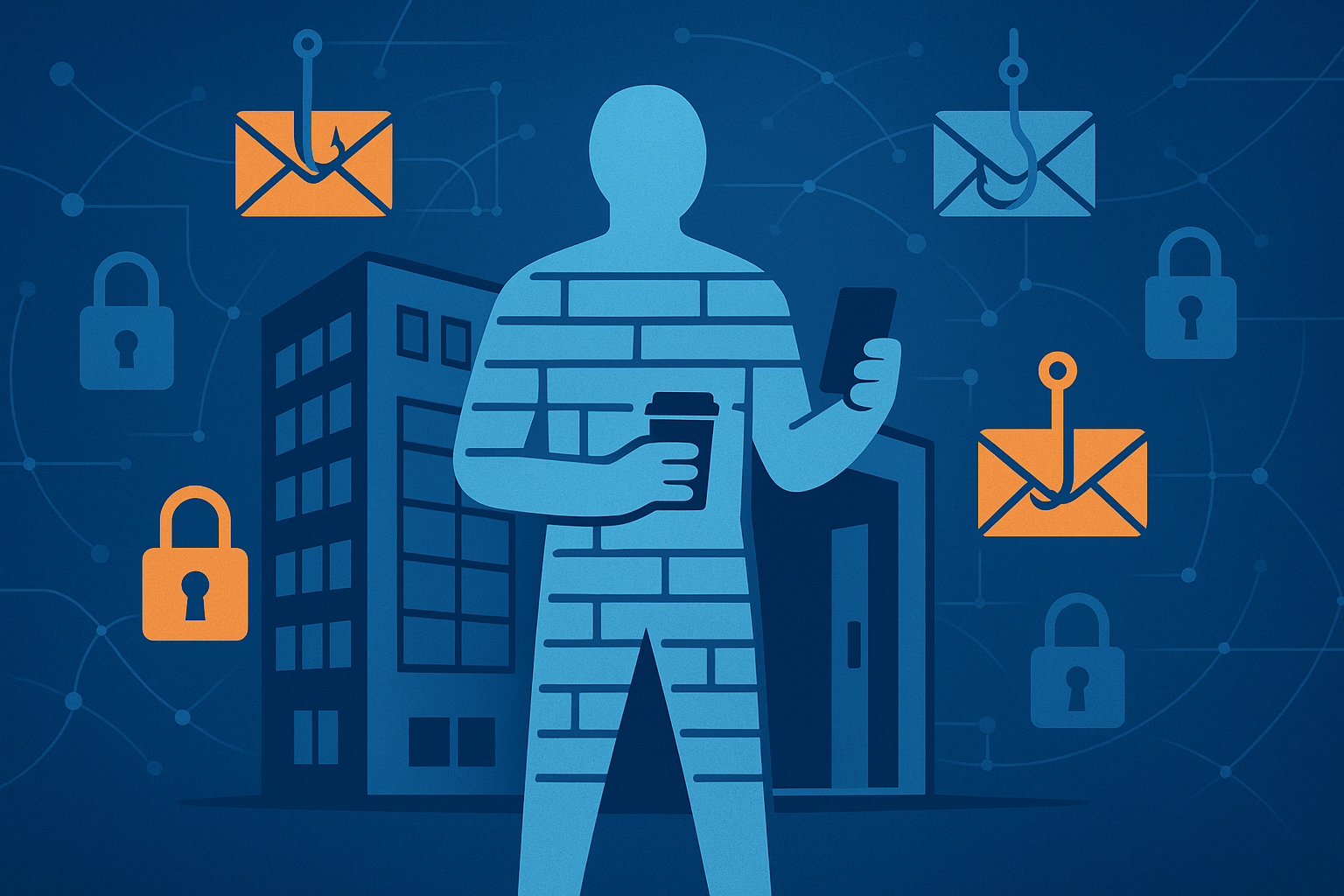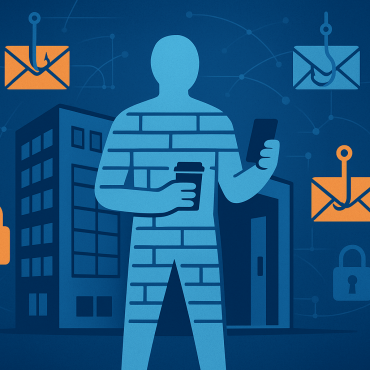
FortiShield Makes Compliance Simple
Compliance Made Simple: HIPAA, PCI DSS, and SOC 2 Without the Headache Regulatory compliance doesn’t have to be the business nightmare that keeps you awake at 3 AM. Whether you’re ...
Cybercrime FSTGKyFu todayAugust 7, 2025

Your firewall is military-grade. Your passwords are 16 characters of random complexity. Your network is segmented, monitored, and locked down tighter than Fort Knox. But your biggest vulnerability just walked through the front door with a coffee in one hand and their smartphone in the other.
Here’s the uncomfortable truth: 95% of successful cyberattacks exploit human error, not technical weaknesses. Your employees—the very people you trust to drive your business forward—are unknowingly opening the door to cybercriminals every single day.
But here’s what most cybersecurity companies won’t tell you: this isn’t your employees’ fault. It’s a training problem with a training solution.
Table of Contents
ToggleBefore we dive into solutions, let’s understand why even your most intelligent, careful employees become cybersecurity liabilities. It’s not about intelligence—it’s about psychology.
Cybercriminals are master manipulators. They don’t just send random phishing emails hoping someone clicks. They study human behavior, exploit cognitive biases, and craft attacks that bypass our rational thinking entirely.
The Authority Bias: An email from “IT Support” demanding immediate password verification triggers our instinct to comply with authority figures. Even when the email address is suspicious, our brain processes the authority claim first.
The Urgency Trap: “Your account will be suspended in 30 minutes unless you verify immediately.” Time pressure short-circuits critical thinking. When people feel rushed, they make mistakes.
The Familiarity Exploit: Modern phishing emails perfectly mimic legitimate communications from Microsoft, Google, or your bank. The visual design, language, and branding are indistinguishable from the real thing.
The Social Engineering Advantage: Attackers research your company on LinkedIn, identify key personnel, and craft personalized messages that reference real projects, colleagues, and business relationships.
Let’s look at what these “simple” human errors actually cost businesses:
The $60 Million Wire Transfer: A finance manager at a technology company received an email that appeared to be from the CEO, requesting an urgent wire transfer to complete an acquisition. The email looked legitimate, referenced a real deal in progress, and came during a busy period when the CEO was traveling. One click later, $60 million was gone.
The Healthcare Breach: A nurse at a medical practice clicked on what appeared to be a patient referral document. That single click installed ransomware that encrypted 40,000 patient records, resulted in $2.3 million in HIPAA fines, and forced the practice to close for three weeks.
The Manufacturing Shutdown: An accounts payable clerk opened an “invoice” attachment that contained malware. The attack spread through the network, shutting down production lines for 12 days and costing the company a major contract worth $15 million.
These weren’t careless employees—they were dedicated professionals trying to do their jobs efficiently. The attacks were just that sophisticated.
Today’s phishing attacks bear no resemblance to the obvious scams of the past. Here’s how a typical modern attack unfolds:
Phase 1: Reconnaissance
Phase 2: Crafting the Attack
Phase 3: The Psychological Hook
Phase 4: The Payload
Most companies approach cybersecurity training like a compliance checkbox. Annual presentations, generic phishing simulations, and policy documents that nobody reads. This approach fails because:
It’s Not Realistic: Generic training scenarios don’t reflect the sophisticated, personalized attacks employees actually face.
It’s Not Memorable: One-time presentations are quickly forgotten when employees face real pressure and deadlines.
It’s Not Measurable: Companies can’t track whether training actually changes behavior or just checks a compliance box.
It’s Not Adaptive: Training doesn’t evolve based on new attack techniques or individual employee vulnerabilities.
At FortiShield Tech Group, we’ve revolutionized security awareness training by treating it like what it actually is: behavioral change management. Our approach doesn’t just educate employees—it fundamentally changes how they think about and respond to potential threats.
Real-World Simulation Training: We create phishing simulations that mirror actual attacks targeting your industry. These aren’t generic “Nigerian prince” scenarios—they’re sophisticated, personalized attacks that test your employees’ ability to recognize real threats.
Immediate Feedback Learning: When an employee falls for a simulation, they receive immediate, constructive feedback explaining exactly what made the attack convincing and how to recognize similar attempts in the future.
Progressive Difficulty: Our training starts with obvious threats and gradually increases sophistication, building employees’ “threat recognition muscles” over time.
Behavioral Reinforcement: Regular micro-learning sessions reinforce key concepts without overwhelming busy employees. Five-minute monthly refreshers are more effective than hour-long annual presentations.
Our clients see dramatic improvements in security awareness metrics:
95% Reduction in Phishing Click-Rates: After implementing our training program, the average employee click-rate on phishing simulations drops from 30% to less than 2%.
99% Endpoint Compliance: Employees consistently follow security protocols, maintaining near-perfect compliance with security policies.
Faster Threat Reporting: Employees who receive suspicious emails report them to IT within minutes rather than ignoring them or falling victim.
Cultural Transformation: Security becomes part of the company culture, not just an IT responsibility.
Email phishing is just one vector. Our comprehensive approach addresses all human-related security risks:
Physical Security Awareness: Training employees to recognize social engineering attempts, tailgating, and physical security breaches.
Remote Work Security: Best practices for home office security, public Wi-Fi usage, and device management.
Social Media Awareness: Understanding how oversharing on social platforms provides ammunition for targeted attacks.
Incident Response Training: Teaching employees how to recognize when they’ve been compromised and how to respond quickly to minimize damage.
Consider this cost-benefit analysis:
Cost of Comprehensive Security Awareness Training:
Cost of a Single Successful Attack:
The math is simple: preventing one successful attack pays for decades of training.
The goal isn’t to make employees paranoid—it’s to make them confidently security-aware. When employees understand threats and feel empowered to recognize and report them, they become your strongest defense layer.
Key Cultural Shifts We Help Create:
From Fear to Empowerment: Employees learn to see themselves as security heroes, not potential victims.
From Blame to Learning: Mistakes become learning opportunities, not reasons for punishment.
From Compliance to Engagement: Security becomes something employees actively participate in, not something imposed on them.
From Individual to Team: Security becomes a shared responsibility that everyone takes pride in.
Ask yourself these critical questions about your current security awareness:
□ When did your employees last receive realistic phishing simulation training?
□ Do you know your current phishing click-rate baseline?
□ Can employees quickly identify and report suspicious emails?
□ Do you have metrics showing whether security training actually changes behavior?
□ Are employees comfortable reporting potential security incidents without fear of blame?
□ Does your training address current, sophisticated attack techniques?
If you answered “no” or “I don’t know” to any of these questions, your human firewall has gaps that cybercriminals will exploit.
Your employees don’t have to be your biggest vulnerability. With proper training, they can become your most effective security control.
Ready to build an unbreachable human firewall?
FortiShield Tech Group’s comprehensive security awareness program has helped clients across the continental United States reduce phishing susceptibility by 95% while building security-conscious cultures that actively defend against threats.
Our interactive workshops, realistic simulations, and ongoing reinforcement training transform employees from potential victims into confident security defenders.
Get started today:
Security Assessment Line: (239) 427-4684
Program Information: GoForti.com
Direct Contact: Hello@GoForti.com
Don’t let human error be the weak link that breaks your security chain. Contact FortiShield Tech Group today and discover how to turn your greatest vulnerability into your strongest defense.
FortiShield Tech Group: Transforming cybersecurity through comprehensive protection that includes technology, processes, and people. Serving businesses nationwide with 24/7/365 monitoring and the industry’s most effective security awareness training.
Written by: FSTGKyFu

Business FSTGKyFu
Compliance Made Simple: HIPAA, PCI DSS, and SOC 2 Without the Headache Regulatory compliance doesn’t have to be the business nightmare that keeps you awake at 3 AM. Whether you’re ...



Copyright © 2025 -- A Cyber Security Design by FortiShield Tech Group
Post comments (0)